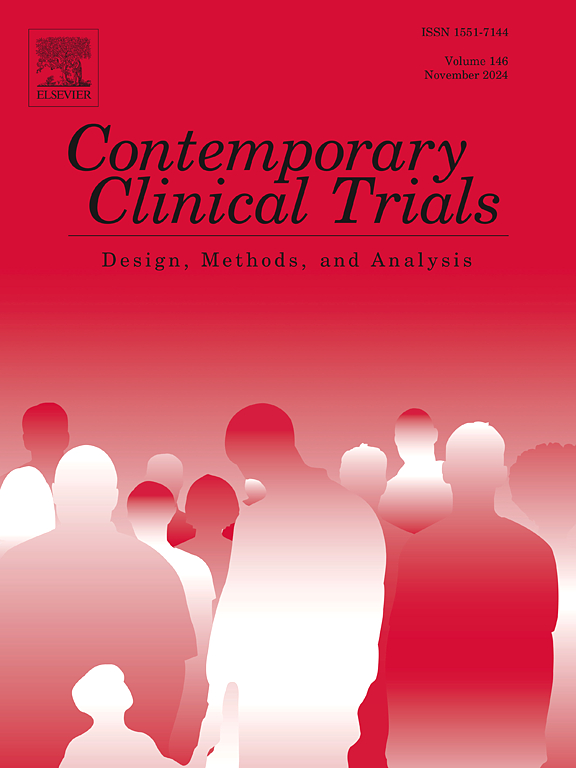Efficient stage-wise allocation ratios in multi-arm multi-stage designs
IF 2
3区 医学
Q3 MEDICINE, RESEARCH & EXPERIMENTAL
引用次数: 0
Abstract
Background
Multi-arm multi-stage (MAMS) designs allow the simultaneous evaluation of multiple treatments across several stages. Due to their potential to accelerate drug development, researchers are continuously seeking ways to improve MAMS designs. This study focuses on the impact of varying allocation ratios at each stage on statistical power and the expected sample size (ESS).
Methods
We present a methodology for calculating the operating characteristics of MAMS designs with varying stage-wise allocation ratios, where the maximum sample size is fixed. We evaluate the impact of various common allocation ratio combinations on three types of power: marginal, disjunctive, and conjunctive, assuming equal sample size across stages. The allocation ratio at any stage is assumed to be equal for all experimental arms, and outcomes are assumed to follow a normal distribution. The parameters used in our evaluation, such as sample size and treatment effects, are derived from a real trial.
Results
Our results demonstrate that efficient stage-wise allocation ratios vary by power type. Both marginal and disjunctive power increase when more patients are allocated to the control arm, but the efficient stage-wise allocation ratio differs for each. Conversely, conjunctive power benefits from a more balanced allocation between control and experimental arms. Variations in allocation ratios resulted in minor changes to ESS.
Conclusions
Our findings highlight the importance of considering stage-wise allocation ratios to align with the specific objectives of a trial. Stage-wise allocation ratios can enhance power and efficiency in MAMS trials, facilitating better decision-making and minimising resource use.
多臂多级设计中有效的分段分配比
多臂多阶段(MAMS)设计允许在多个阶段同时评估多个处理。由于其加速药物开发的潜力,研究人员正在不断寻求改进MAMS设计的方法。本研究的重点是在每个阶段不同的分配比例对统计能力和预期样本量(ESS)的影响。我们提出了一种方法来计算具有不同阶段分配比率的MAMS设计的工作特性,其中最大样本量是固定的。我们评估了各种常见分配比例组合对三种类型权力的影响:边际、析取和合取,假设各阶段的样本量相等。假设所有实验臂在任何阶段的分配比例相等,并且假设结果服从正态分布。在我们的评估中使用的参数,如样本量和处理效果,都来自真实的试验。结果我们的研究结果表明,有效的阶段分配比率因功率类型而异。当更多的患者被分配到对照组时,边际功率和分离功率都会增加,但每个阶段的有效分配比例不同。相反,联合能力则受益于控制臂和实验臂之间更平衡的分配。分配比例的变化导致ESS的微小变化。结论:我们的研究结果强调了考虑分期分配比例以配合试验的具体目标的重要性。分阶段分配比例可以提高MAMS试验的功率和效率,促进更好的决策并最大限度地减少资源使用。
本文章由计算机程序翻译,如有差异,请以英文原文为准。
求助全文
约1分钟内获得全文
求助全文
来源期刊
CiteScore
3.70
自引率
4.50%
发文量
281
审稿时长
44 days
期刊介绍:
Contemporary Clinical Trials is an international peer reviewed journal that publishes manuscripts pertaining to all aspects of clinical trials, including, but not limited to, design, conduct, analysis, regulation and ethics. Manuscripts submitted should appeal to a readership drawn from disciplines including medicine, biostatistics, epidemiology, computer science, management science, behavioural science, pharmaceutical science, and bioethics. Full-length papers and short communications not exceeding 1,500 words, as well as systemic reviews of clinical trials and methodologies will be published. Perspectives/commentaries on current issues and the impact of clinical trials on the practice of medicine and health policy are also welcome.

 求助内容:
求助内容: 应助结果提醒方式:
应助结果提醒方式:


